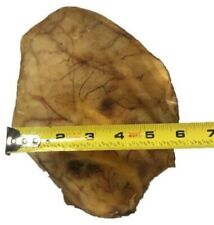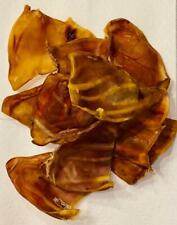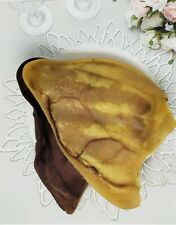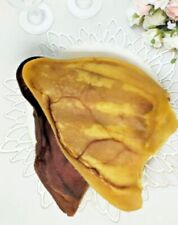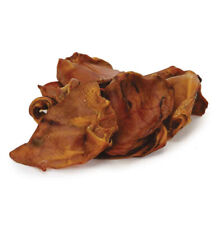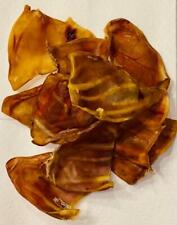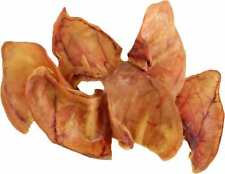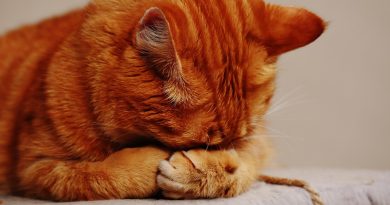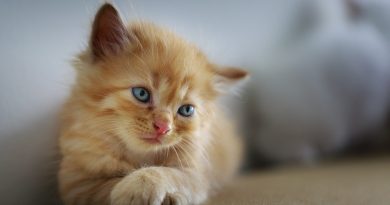Little Known Feline Ailments

Collapsible Legs
Symptoms:
The affected cat places one side of its head on the ground as though cheek-marking the concrete, carpet etc. After several such maneuvers, the legs on that side of the cat suddenly collapse, leaving the cat waggling its feet in the air.
Treatment:
This involves placing the palm of one hand on the exposed belly and rubbing gently. There are side-effects though – some feline sufferers attack the rubbing hand while others recover spontaneously, often after prolonged treatment. This condition is probably incurable and any cat which requires prolonged treatment after an attack will most likely suffer repeated attacks of collapsible legs throughout its lifetime.
Snudging
Symptoms:
The affected cat repeatedly head butts any available part of a readily available human and turns its head slightly so that the lips and cheek are rubbed against legs, arms, clothing etc. This condition gets its name from a contraction of the phrase "soggy nudging". Snudging may well be a form of excessive scent-marking. A bad attack can result in soggy clothing.
Treatment:
Give the sufferer lavish affection. Most attacks subside between 10 minutes to 1 hour after onset of symptoms. You may need to dry off snudged clothing or skin. Attacks recur frequently, usually when the most readily available human is engrossed in a TV program, book or telephone call.
Bed-Hogging
Symptoms:
The cat spreads to take up all available free bed space at night. It then expands a bit more until any human occupants occupy the smallest possible area of bed. It may do this on top or underneath the covers or on the pillow. It is highly contagious – any other cats on the bed will also develop symptoms of bed-hogging.
Treatment:
The most obvious solution is to evict the cat from the bed. If this is morally unfeasible, train yourself not to give way as the cat expands. Buying a bigger bed is probably pointless as most affected cats can easily expand to fill standard, queen-sized and king-sized beds. Otherwise, simply train yourself to sleep while hanging precariously off the side of the bed. Attacks of bed-hogging have been known to last up to 23 hours (in one case a 3-day attack was noted by a cat-owner who was confined to bed with flu; the cat thoughtfully kept her company during this time).
Non-Specific Insect Infestation
Symptoms
A disorder more prevalent among outdoor-going cats and cats with access to conservatories and garden rooms. Symptoms range from minor (the odd greenfly in tail, money-spider on fur) to severe (entire ecosystems of insects living on cat, spider webs spun between ears/whiskers, cat so weighed down with spider webs that it has difficulty walking).
Treatment
Minor symptoms can be treated by simply removing the infesting agent (aphid, ladybug, spider etc) and combing webs out of fur. If the cat suffers recurrent or severe symptoms an exercise regime is highly recommended since highly mobile cats appear to attract fewer greenfly (research into this factor continues).
Fuffling
Symptoms
The cat lowers its nose into water and exhales. This is followed by whiffling, spluttering, sneezing, snorting, head-shaking and a generally confused expression. Bath-foam appears to trigger attacks of fuffling in some cats. It may also be linked to interesting items seen in the water e.g. goldfish, food-crumbs, greeblingz. Fuffling is most common during kittenhood although even quite elderly may suffer an occasional bout.
Treatment
None. Snorkelling apparatus or scuba suits are possibilities, but cats do not readily accept such treatment. Kittenhood fuffling generally subsides as the cat grows older, possibly due to some acquired immunity (or greater common sense).
Irritable Lap Syndrome
Symptoms
The cat appears unable to settle comfortably on laps, instead treading, kneading, rearranging itself, fidgeting, vocalizing, getting up and turning around, falling off lap and getting back on again, attacking magazines, needlework, computer keyboard, telephone etc.
Treatment
Immediate treatment is essential. Drop whatever you are doing (literally if need be) and give 100% attention to the sufferer otherwise symptoms may escalate and become quite distressing to the lap-owner. Only prolonged attention will cure an attack of Irritable Lap Syndrome. Like Collapsible Legs this syndrome is incurable, although attacks may be effectively treated as and when they occur.
Lap Fungus Disorder
Symptoms
Having taken over a human lap, the cat proceeds to ‘spread’ in all planes. This may be accompanied by secondary symptoms such as high volume purring, dribbling, kneading and snoring. The condition is highly contagious and several ‘fungoid’ cats may infest a lap simultaneously.
Treatment
Topical treatment with proprietary anti-fungals is ineffective. Prompt treatment (as per Irritable Lap Syndrome) is required to alleviate the worst symptoms although in a number of cats, such treatment actually aggravates the condition. This disorder manifests itself periodically through the affected cat’s life and there is no long-term cure.
Smurgling
Symptoms
Varied:- sucking at clothing, owners earlobes/nose/fingers/skin, drooling, glazed expression. Often accompanied by kneading and high volume purring.
Treatment
Ultimately incurable. It is possible to remove smurglable items from around the cat. The ailment may be transmitted to humans in the form of large laundry bills, mis-shapen clothing and chapped skin.
Greeblingz
Symptoms
Random dashes through to helter-skelter running through house in pursuit of unseen prey. Greeblingz are believed to be non-visible entities and some authorities have linked them to UFO sightings or feel that they may be diminutive other-dimensional beings. Cats suffering from greeblingz typically have wild-eyed expressions. There is a minor danger of greeblingz attaching themselves to humans; if a cat tackles such greeblingz, injury to humans may result. A very few cats are naturally immune. In some areas, this condition is known as the Flaming Kahooties.
Treatment
None known. Anti-epileptics are ineffective as the condition appears unrelated to other forms of seizure. Avoid getting in the way of a cat engaged in greebling hunting. Attacks usually subside spontaneously, perhaps as greeblingz return to their own dimension. These irritating creatures are not visible to human eyes, but no doubt the superior sight and hearing of cats enables them to see them.
Marshmallow Paws
Symptoms
Over a period of time, the paw pads change from tough skin to soft squishy marshmallow paws. The cat shows no sign of distress, however it may exhibit a preference for being carried everywhere. This condition is most often noticed in inactive cats. Afflicted cats may sleep excessively, often in a belly-up position with the marshmallow paws waggling in the air. Possibly, paw softening is due to lack of contact between paw and floor. In technical terms, the paw pads are ‘kitten-soft’.
Treatment
Increased paw-to-floor contact is essential. The cat must be encouraged to use its own feet instead of its human’s feet. The use of a treadmill, while effective, may lead to SPCA investigations. Many old, inactive cats suffer from irreversible marshmallow paws. If a regime of exercise is adopted, it must be maintained for the rest of the cat’s life – marshmallow paws is a recurrent condition.
Happy Coat
Symptoms
Most often noted in sleek-furred cats. The cat proceeds to fluff up its fur in pleasure, starting at the base of the tail and working forward towards the nose. In extreme cases the cheeks and forehead fluff up and the cat is said to have ‘purred itself fuzzy’. Happy Tongue is typified by a small part of the tongue protruding from the mouth until the cat remembers to tuck it away again. Happy Coat and Happy Tongue are frequently accompanied by Irritable Lap Syndrome or Smurgling and may be a prelude to an attack of Collapsible Legs.
Treatment
None known. Spontaneous attacks of Happy Coat are most distressing to exhibitors of slinky-haired cats. Happy Tongue in Persians is sometimes misdiagnosed as a malformed mouth. It is, of course, possible to make the cat unhappy, but this is not recommended. Some cats grow out of these conditions.

